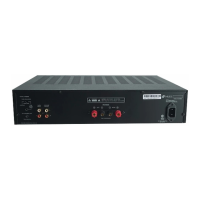What to do if my Niles SI-275 will not turn on?
- JJohn WongJul 30, 2025
If your Niles Amplifier doesn't turn on, ensure the AC power cord is properly plugged into a working outlet and that the master power switch is turned on.

What to do if my Niles SI-275 will not turn on?
If your Niles Amplifier doesn't turn on, ensure the AC power cord is properly plugged into a working outlet and that the master power switch is turned on.
Why is there a hum coming from the speakers connected to my Niles SI-275?
If you are experiencing hum from the speakers connected to your Niles Amplifier, it might be due to a ground loop between components. Try reversing the AC plugs of each component in your system to test for this. Also, check for faulty cables, source material, an ungrounded phono system, or a defective component.
What to do if there is no sound on one channel of my Niles Amplifier?
If you have no sound on one channel of your Niles Amplifier, check the connections at the speaker or amplifier terminals for short circuits or loose wires. Ensure connections are secure and no wire strands cross from positive to negative terminals. Disconnect the speaker wire at both ends, separate the conductors, and test with a meter for shorts. If no short is found, connect the conductors at one end and test for continuity. You can also connect the speaker to a channel that plays another speaker. Finally, try connecting another audio cable that is known to be good.
Why does the bass sound weak and the stereo image blurry with my Niles SI-275?
If you experience weak bass and a blurry stereo image in one room with your Niles Amplifier, the loudspeakers might be wired out of phase. To correct this, reverse the connections at the back of one speaker.
What to do if there is no sound on both channels of my Niles SI-275?
If there is no sound on both channels of your Niles Amplifier, the audio cable to the main inputs could be faulty. Try connecting another cable that is known to be good.
Offers three turn-on modes: Music Sense, External Voltage Trigger, Manual Turn-On.
Equipped with protection circuits that automatically shut off the amplifier if a problem occurs.
Place on a flat level surface, upright, ensuring adequate ventilation for proper cooling.
Explains the master power switch, Power LED, Active LED, and Protection LED.
Troubleshooting steps for issues with sound in a single channel.
Troubleshooting steps for complete loss of audio output.
Identifies causes of hum, such as ground loops, and suggests testing procedures.
Further checks for hum: faulty cables, source material, or components.
Checks for proper AC power connection and master power switch status.
Addresses issues like out-of-phase loudspeaker wiring.
Covers power output, input sensitivity, voltage gain, frequency response, and THD.